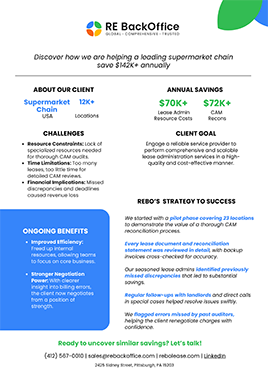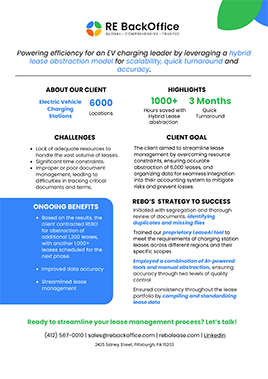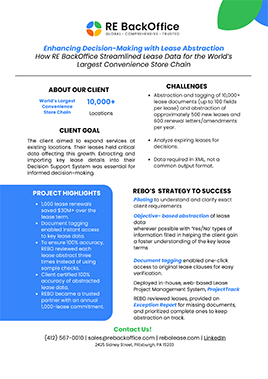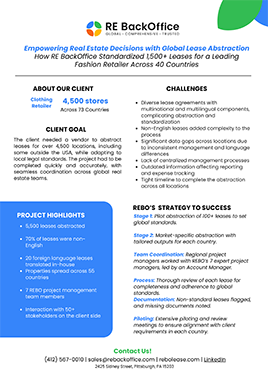
Commercial real estate leases are integral to the operation of various types of properties, from retail and office spaces to industrial buildings. Understanding the nuances of different lease types is crucial for both landlords and tenants. This comprehensive guide delves into the specifics of retail, office and industrial leases, focusing on their unique provisions and how recoveries, where tenants pay back landlords based on shared expenses, factor into these agreements. A detailed exploration of net leases, gross leases, full-service gross leases, and modified gross leases is provided, including practical examples to illustrate their applications.
Retail Lease
Retail leases are tailored for businesses that operate in retail environments. These leases typically include provisions for common area maintenance (CAM) fees, rules about signage, and guidelines for store appearance. The goal is to ensure that the retail environment remains attractive and functional for all tenants and customers. For instance, a retail lease may stipulate that tenants maintain their storefronts according to certain standards, contribute to the upkeep of shared spaces like parking lots and walkways, and follow specific rules for signage to maintain a cohesive aesthetic. These provisions help create a uniform and appealing shopping environment, which can enhance the overall customer experience and drive business for all tenants in the retail complex.
Office Lease
Office leases focus on the needs of businesses using the space for administrative purposes. These leases often include provisions for utilities, cleaning services, and office hours. For example, an office lease might specify the hours during which the building is accessible, outline responsibilities for cleaning common areas, and detail how utility costs are shared among tenants. This type of lease ensures that office environments are conducive to productivity and professionalism. Additionally, office leases may include clauses regarding the maintenance of shared facilities such as conference rooms, lobbies, and restrooms, ensuring that these areas remain clean and functional for all tenants.
Industrial Lease
Industrial leases are designed for spaces used for warehousing, manufacturing, or heavy equipment operations. These leases cover terms related to the use of heavy equipment, adherence to safety regulations, and maintenance responsibilities. An industrial lease might include clauses on the proper handling of hazardous materials, the maintenance of machinery, and compliance with industry-specific safety standards. This ensures that industrial spaces remain safe and efficient for their intended uses. Industrial leases may also specify conditions for modifications or alterations to the property, which are often necessary for specialized industrial operations.
Residential Lease
Residential leases are generally shorter and less complex compared to commercial real estate leases. They cover living arrangements, utilities, and basic maintenance responsibilities. A residential lease typically outlines the tenant's responsibilities for paying utilities, maintaining the living space, and adhering to community rules. These leases provide a clear framework for the landlord-tenant relationship, ensuring a comfortable and well-maintained living environment. Residential leases also often include provisions for pet policies, subletting, and the use of common amenities such as pools or gyms.
Lease Types Based on Expense Recoveries
The type of lease agreement significantly influences how expenses are managed and recovered. The main types of leases based on expense recoveries are net leases, gross leases, full-service gross leases, and modified gross leases.
Net Lease
In a net lease, the tenant is responsible for paying a base rent plus a pro rata share of property expenses. If the tenant leases the entire building, they are directly responsible for its maintenance and operation. This means the tenant pays the base rent along with their share of common area expenses, taxes, insurance, and utilities. For instance, if the total property expenses for a year amount to $20,000 and the tenant's share is 10%, they would pay an additional $2,000 on top of their base rent. This structure ensures that the landlord receives a steady income while sharing the burden of property expenses with the tenant. Net leases are often preferred in situations where tenants can directly manage their share of expenses and have control over certain aspects of the property's maintenance and operations.
Gross Lease
In a gross lease, the landlord covers most property expenses, including common area expenses, real estate taxes, and building insurance. The tenant only pays a lump sum rent amount, which includes these expenses, excluding utilities. This means the tenant is responsible for their utility consumption, but all other costs are covered by the landlord. For example, a tenant might pay $7,500 per month in rent, which includes CAM, insurance, and taxes. This type of lease simplifies the tenant's financial obligations, making it easier to budget for monthly expenses. Gross leases are particularly beneficial in scenarios where tenants prefer a predictable rent structure without the need to manage variable costs related to property maintenance and operations.
Full-Service Gross Lease
A full-service gross lease takes the concept of a gross lease a step further by including utilities in the rent. The landlord pays for taxes, maintenance, insurance, and utilities, regardless of any increase in operating expenses. This means the tenant pays a single rent amount that covers all costs associated with the property. For example, an office tenant might pay $8,000 per month, which includes rent, utilities, CAM, insurance, and taxes. This arrangement provides maximum convenience for the tenant, as they do not have to manage multiple payments or worry about fluctuating utility costs. Full-service gross leases are often used in premium office buildings and high-end commercial real estate properties where tenants expect comprehensive service and minimal responsibility for additional costs.
Modified Gross Lease
A modified gross lease is a hybrid of net and gross leases. In this arrangement, the tenant pays a base rent plus a share of any increase in property expenses beyond the first year, known as the base year. For example, if property expenses increase by $10,000 from the base year and the tenant's share is 10%, they would pay an additional $1,000. This means that during the first year, the tenant only pays the base rent, but in subsequent years, they contribute to any increase in operating expenses. This structure allows for a more predictable initial rent while sharing the risk of increasing expenses between the landlord and tenant. Modified gross leases strike a balance between the predictability of a gross lease and the flexibility of a net lease, making them suitable for a variety of commercial tenants.
Practical Examples
To better understand these lease types, consider a series of practical examples:
Net Lease Example
A tenant pays a base rent of $6,000 per month. The property expenses for the first year are $10,000, and the tenant's share is 10%, resulting in an additional $1,000. Thus, the total payment for the first year is $7,000 ($6,000 base rent + $1,000 expenses). Over the lease term, if expenses increase to $20,000, the tenant's share would be $2,000, making the total payment $8,000 for that year. Net leases allow tenants to see a direct correlation between their payments and the actual property expenses, which can be advantageous for budgeting and financial planning.
Gross Lease Example
In a gross lease, the tenant pays a flat monthly rent that includes all property expenses. If the agreed-upon rent is $7,000 per month, the tenant does not pay additional expenses for CAM, insurance, or taxes. This simplifies the payment structure and provides a stable monthly rent, which can be advantageous for budgeting purposes. Gross leases are particularly useful for tenants who prefer to avoid the complexities of calculating and managing shared property expenses.
Full-Service Gross Lease Example
Under a full-service gross lease, the tenant pays a single rent amount that includes all property expenses and utilities. If the monthly rent is $8,000, this covers base rent, CAM, insurance, taxes, and utilities. The tenant benefits from a straightforward payment structure and does not need to worry about fluctuating utility costs. Full-service gross leases offer the highest level of convenience and predictability, making them ideal for tenants who prioritize simplicity and comprehensive service.
Modified Gross Lease Example
In a modified gross lease, the tenant pays the base rent of $6,000 for the first year. If property expenses increase by $10,000 in the second year, the tenant's 10% share results in an additional $1,000 payment. Thus, the total payment for the second year is $7,000 ($6,000 base rent + $1,000 expenses). If expenses decrease in subsequent years, the tenant's payments reflect only the base rent and any applicable increases over the base year. Modified gross leases provide a balance between the stability of initial rent and the flexibility to share future expense increases.
Understanding the differences between net, gross, full-service gross, and modified gross leases is essential for navigating commercial real estate transactions. Each lease type has unique features that impact how expenses are managed and shared between landlords and tenants. By examining the specific provisions and practical examples of each lease type, tenants and landlords can make informed decisions that best suit their financial and operational needs. Whether opting for the predictability of a gross lease or the shared expense structure of a net lease, understanding these lease types ensures a smoother leasing experience for all parties involved.
Careful review and understanding of the payment obligations within each lease type are crucial. Each negotiation may vary based on tenant preferences, making it imperative to thoroughly analyze lease terms before finalizing agreements. By doing so, tenants and landlords can establish clear, mutually beneficial arrangements that support the successful operation and maintenance of commercial real estate properties.


